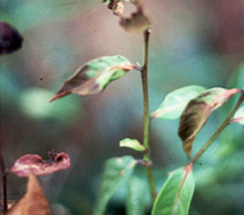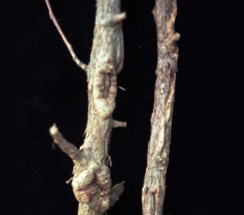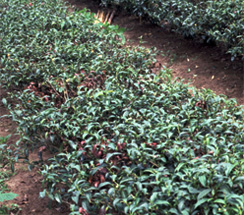Twig dieback, stem canker: Macrophoma theicola
Symptoms
- The first symptoms include browning and drooping of affected leaves.
- As the disease spreads into the shoots, they become dry and die.
- The entire branch can die from the tip downward.
- Dying branches often have cankers—shallow, slowly spreading lesions surrounded by a thick area of bark.
 |
 |
 |
 |
| Browning |
Dried leaves |
Stem canker |
Infected field |
Life cycle
- The fungus produces spores on small, pear-shaped pycnidia on dead branches.
- Spores are spread when splashed by rain and can survive for several weeks on pruned branches left in the field.
- The fungus usually requires wounded plant tissue to gain entry and initiate infection.
Management
- Plant in well draining, acidic soils.
- Remove diseased twigs by cutting several inches below cankered areas and disinfecting them.
- Spray appropriate protective fungicides during periods of wet weather or natural leaf drop to protect leaf scars from infection
Content validator: Dr. M. Deivamani, Assistant Professor, Horticulture Research Station, Yercaud-636602.
Image source:
Keith, l., Ko, W.H and Sato D.M. 2006. Identification Guide for Diseases of Tea (Camellia sinensis). Plant Disease, 33, pp-1-4. |




